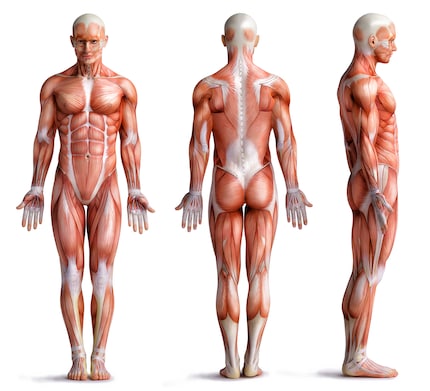
Background information
Strength training – making your muscles 30 years younger
by Claudio Viecelli

You can’t live without muscles: sounds strange, but it’s true. Why, though? Well, it might just all have to do with some fundamental scientific findings.
In the average body, muscle will be the most abundant tissue. Mechanically, the function of muscles is to convert chemical into mechanical energy. This generates power, enabling us to move. From a metabolic perspective, muscles store proteins, carbohydrates, fats, minerals and inorganic salts. These energy sources supply muscle fibres during physical activity and maintain your metabolism. So, in addition to generating force, muscles also store energy, thus contributing significantly to our survival.
Fortunately, or less so, depending on how you look at it, we age. Ageing is characterised by a decrease in the functional capacity of our body. The rate at which we age is highly individual and dependent on differences in lifestyle, activity, genes and other factors. Our musculature is also affected by this process. By the time we hit our 80th year on this earth, we’ve already lost around 30 per cent of our maximum muscle mass due to ageing. Muscle makes up as much as 40 per cent of a person’s total body mass, so this age-related loss, known as sarcopenia, has a substantial impact on health and quality of life.
As there’s a relationship between muscle mass and bone density, decreasing muscle mass also leads to a decrease in bone mass. Loss of bone density is also called osteopenia and, along with sarcopenia, poses major challenges to our health. Impairment of our musculoskeletal system leads to balancing problems, for example, thus increasing our risk of falling. Less dense bones break more easily in falls, leading to frequent hospitalisations of the elderly. This drives up health care costs enormously. In 2016, sarcopenia affected one quarter of all elderly people in Switzerland.

Fortunately, muscle is an adaptable tissue. It constantly adapts to different physiological conditions, such as mechanical or energy stress, inactivity, hypoxia, weightlessness, cold, and nutritional changes. Therefore, whether through activity (exercise) or a lack thereof (disuse, illness, injury), adaptation takes place, and this adaptability is maintained throughout life.
By physical activity, we mean the movement of the human body by way of muscles, which releases energy. This was an evolutionary advantage, as it enabled travel and the discovery of new habitats. The evolution of movement coincided with the evolution of hunting and gathering, in that foraging significantly increased physical activity.
Voluntary physical activity that is planned, structured, and repeated to maintain or improve health and fitness is called exercise. Exercise challenges the body’s metabolic balance and causes an orchestrated systemwide response that allows the metabolic demands of contracting muscles to be balanced. The resulting metabolic and structural adaptations are highly exercise-dependent. Various combinations of intensity and duration allow for a wealth of exercise types. Two of the most intensively studied types of exercise are endurance and strength training.
Endurance training is usually characterised by continuous activity at lower intensities that allow the exerciser to maintain stress for a longer period of time. Typical forms of endurance training include walking, running, cycling and swimming. Prolonged muscular activity at lower intensities presents a challenge to the metabolic system. These metabolic disturbances set physiological processes in motion: new mitochondria, often referred to as the powerhouse of the cell, are created. Furthermore, these processes regulate capillary action and energy utilisation. The goal of endurance training is therefore often to increase aerobic performance. Aerobic exercise denotes a process in which the amount of oxygen inhaled is sufficient to supply the required energy to a working muscle. Anaerobic exercise is the point at which the body can no longer cover its energy production from oxygen transport through the blood.
Unlike endurance training, strength training involves short, maximum intensity contractions. Strength training challenges the mechanical integrity and metabolic balance of muscles. Systematic, mechanical and metabolic stress on the body leads to structural and neural adaptations. These adaptations include, for example, changes in muscle fibre size and architecture as well as mitochondrial proliferation, tendon stiffness and thickness, firing frequency (the neuronal gating of muscles), and much more.

Since strength training increases muscle mass in men and women of all ages, it’s the only non-pharmacological countermeasure to combat sarcopenia. This is good news, as we can now interrupt the loss of muscle mass.
Strength training consists of modifiable factors such as exercise type, diet, training experience and non-modifiable factors such as age, gender, genotype. Both types of factors are processed in our bodies and influence the resulting adaptations. However, the most important modifiable factor, the basis of any training-dependent adaptation, is the strength training itself.
Several modifiable factors are known in strength training. These were assigned mechano-biological descriptors and go as follows:
| x1 | Load magnitude |
|---|---|
| x2 | Number of repetitions |
| x3 | Number of sets |
| x4 | Rest in-between sets |
| x5 | Number of exercise interventions |
| x6 | Duration of exercise |
| x7 | Muscle use |
| x8 | Time under tension |
| x9 | Volitional muscular failure |
| x10 | Range of motion |
Table: Mechano-biological descriptors of resistance training. Adapted from Toigo and Boutellier, 2006
In the coming weeks, we will systematically highlight each of the mechano-biological descriptors of strength training and develop an understanding of efficient and effective strength training.
Molecular and Muscular Biologist. Researcher at ETH Zurich. Strength athlete.
Interesting facts about products, behind-the-scenes looks at manufacturers and deep-dives on interesting people.
Show all